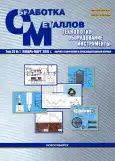Processing of Antimony-tin Concentrates by Vacuum Distillation
- Authors: Korolev A.A.1, Maltsev G.I.1, Timofeev K.L.1, Lobanov V.G.1
-
Affiliations:
- Issue: Vol 20, No 1 (2018)
- Pages: 6-21
- Section: TECHNOLOGY
- URL: https://bakhtiniada.ru/1994-6309/article/view/302056
- DOI: https://doi.org/10.17212/1994-6309-2018-20.1-6-21
- ID: 302056
Cite item
Full Text
Abstract
Keywords
About the authors
A. A. Korolev
Email: gennadymaltsev@mail.ru
JSC "Uralelektromed", gennadymaltsev@mail.ru
G. I. Maltsev
Email: mgi@elem.ru
D.Sc. (Engineering), Associate Professor, JSC "Uralelektromed", mgi@elem.ru
K. L. Timofeev
Email: K.Timofeev@elem.ru
Ph.D. (Engineering), JSC "Uralelektromed", K.Timofeev@elem.ru
V. G. Lobanov
Email: lobanov-vl@yandex.ru
Ph.D. (Engineering), Associate Professor, Ural Federal University, lobanov-vl@yandex.ru
References
- Berman A. Total pressure measurements in vacuum technology. – 1st ed. – New York: Academic Press, 1985. – 412 p. – ISBN 9781483273792.
- Winkler O., Bakish R. Vacuum metallurgy. – Amsterdam: Elsevier Science Ltd., 1971. – 906 р. – ISBN-10: 0444408576. – ISBN-13: 978-0444408570.
- Jia G.-b., Yang B., Liu D.-c. Deeply removing lead from Pb-Sn alloy with vacuum distillation // Transactions of Nonferrous Metals Society of China. – 2013. – Vol. 23, iss. 6. – P. 1822–1831. – doi: 10.1016/S1003-6326(13)62666-7.
- Process optimization for vacuum distillation of Sn–Sb alloy by response surface methodology / A. Wang, Y. Li, B. Yang, B. Xu, L. Kong, D. Liu // Vacuum.
- – 2014. – Vol. 109. – P. 127–134. – doi: 10.1016/j.vacuum.2014.07.013.
- Dai Y.N. Vacuum metallurgy of nonferrous metals. – Beijing: Metallurgical Industry Press, 2009. – P. 72.
- Recycling of metals from waste Sn-based alloys by vacuum separation / B. Yang, L.-x. Kong, B.-q. Xu, D.-c. Liu, Y.-N. Dai // Transactions of Nonferrous Metals Society of China. – 2015. – Vol. 25, iss. 4. – P. 1315–1324. – doi: 10.1016/S1003-6326(15)63730-X.
- Research on the removal of impurities from crude nickel by vacuum distillation / D.C. Liu, B. Yang, F. Wang, Q.C. Yu, L. Wang, Y.N. Dai // Physics Procedia. – 2012. – Vol. 32. – P. 363–371. – doi: 10.1016/j.phpro.2012.03.570.
- Dai Y.N., Yang B. Non-ferrous metals and vacuum metallurgy. – Beijing: Metallurgical Industry Press, 2000. – P. 40.
- Smith J.M., Van Ness H.C., Abbott M.M. Introduction to chemical engineering thermodynamics. – 6th ed. – New York: McGraw-Hill, 2001. – 749 p. – ISBN-10: 0000053759. – ISBN-13: 978-0000053756.
- Tao D.P. A new model of thermodynamics of liquid mixtures and its application to liquid alloys // Thermochimica Acta. – 2000. – Vol. 363, iss. 1–2. – P. 105–113. – doi: 10.1016/S0040-6031(00)00603-1.
- Determination and modeling of the thermodynamic properties of liquid calcium–antimony alloys / S. Poizeau, H.J. Kim, J.M. Newhouse, B.L. Spatocco, D.R. Sadoway // Electrochimica Acta. – 2012. – Vol. 76. – P. 8–15. – doi: 10.1016/j.electacta.2012.04.139.
- Thermodynamic properties of calcium–magnesium alloys determined by emf measurements / J.M. Newhouse, S. Poizeau, H. Kim, B.L. Spatocco, D.R. Sadoway // Electrochimica Acta. – 2013. – Vol. 91. – P. 293–301. – doi: 10.1016/j.electacta.2012.11.063.
- Thermoelectric property of bulk CaMgSi intermetallic compound / N. Miyazaki, N. Adachi, Y. Todaka, H. Miyazaki, Y. Nishino // Journal of Alloys and Compounds. – 2017. – Vol. 691. – P. 914–918. – doi: 10.1016/j.jallcom.2016.08.227.
- Materials science and technology: a comprehensive treatment. Vol. 1. Structure of solids / ed. by V. Gerold. – Weinheim: VCH, 1993. – 621 p.
- Selected values of the thermodynamic properties of binary alloys / R. Hultgren, P.D. Desai, D.T. Hawkins, M. Geiser, K.K. Kelley. – Metals Park, OH: American Society for Metals, 1973. – 1435 p.
- Dai Y., Yang B. Vacuum metallurgy for non-ferrous metals and materials. – Beijing: Metallurgical industry Press, 2000. – 124 p. (In Chinese).
- Application of molecular interaction volume model in vacuum distillation of Pb-based alloys / H.W. Yang, B. Yang, B.Q. Xu, D.C. Liu, D.P. Tao // Vacuum. – 2012. – Vol. 86, iss. 9. – P. 1296–1299. – doi: 10.1016/j.vacuum.2011.11.017.
- Королев А.А., Краюхин С.А., Мальцев Г.И. Равновесные системы «газ–жидкость» для сплава Sb-Ag при вакуумной дистилляции // Обработка металлов (технология, оборудование, инструменты). – 2017. – № 4 (77). – С. 68–83. – doi: 10.17212/1994-6309-2017-4-68-83.
- Measurement and modeling of phase equilibria for Sb-Sn and Bi-Sb-Sn alloys in vacuum distillation / C.B. Nan, H. Xiong, B.-q. Xu, B. Yang, D.C. Liu, H.W. Yang // Fluid Phase Equilibria. – 2017. – Vol. 442. – P. 62–67. – doi: 10.1016/j.fluid.2017.03.016.
- Kinetics of Pb evaporation from Pb-Sn liquid alloy in vacuum distillation / J.Y. Zhao, H.W. Yang, C.B. Nan, B. Yang, D.C. Liu, B.-q. Xu // Vacuum. – 2017. – Vol. 141. – P. 10–14. – doi: 10.1016/j.vacuum.2017.03.004.
- Vapor–liquid phase equilibria of binary tin–antimony system in vacuum distillation: experimental investigation and calculation / L.-x. Kong, J. Xu, B.-q. Xu, S. Xu, B. Yang // Fluid Phase Equilibria. – 2016. – Vol. 415. – P. 176–183. – doi: 10.1016/j.fluid.2016.02.012.
- Experimental and modeling vapor-liquid equilibria: separation of Bi from Sn by vacuum distillation / C.В. Nan, H.W. Yang, B. Yang, D. Liu, H. Xiong // Vacuum. – 2017. – Vol. 135. – P. 109–114. – doi: 10.1016/j.vacuum.2016.10.035.
- Study on azeotropic point of Pb–Sb alloys by ab-initio molecular dynamic simulation and vacuum distillation / B. Song, N. Xu, W. Jiang, B. Yang, X. Chen, B. Xu, L. Kong, D. Liu, Y. Dai // Vacuum. – 2016. – Vol. 125. – P. 209–214. – doi: 10.1016/j.vacuum.2016.01.004.
- Experimental investigation and calculation of vapor–liquid equilibria for Cu–Pb binary alloy in vacuum distillation / C. Zhang, W.L. Jiang, B. Yang, D.C. Liu, B.Q. Xu, H.W. Yang // Fluid Phase Equilibria. – 2015. – Vol. 405. – P. 68–72. – doi: 10.1016/j.fluid.2015.07.043.
- Диаграммы состояния двойных металлических систем. В 3 т. Т. 1: справочник / под общ. ред. Н.П. Лякишева. – М.: Машиностроение, 1996. – 992 с. – ISBN 5-217-02688-X.
Supplementary files






